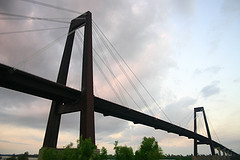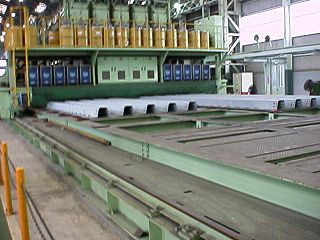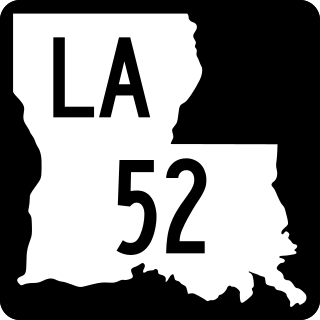Luling is a census-designated place (CDP) in St. Charles Parish, Louisiana. The population was 11,512 at the 2000 census and 12,119 at the 2010 census. At the 2020 census, 13,716 people lived in Luling. It is located on the west bank of the Mississippi River. Luling is part of the New Orleans—Metairie—Kenner metropolitan statistical area.

St. Charles Parish is a parish located in the U.S. state of Louisiana. At the 2020 census, its population was 52,549. The parish seat is Hahnville and the most populous community is Luling.

A cable-stayed bridge has one or more towers, from which cables support the bridge deck. A distinctive feature are the cables or stays, which run directly from the tower to the deck, normally forming a fan-like pattern or a series of parallel lines. This is in contrast to the modern suspension bridge, where the cables supporting the deck are suspended vertically from the main cable, anchored at both ends of the bridge and running between the towers. The cable-stayed bridge is optimal for spans longer than cantilever bridges and shorter than suspension bridges. This is the range within which cantilever bridges would rapidly grow heavier, and suspension bridge cabling would be more costly.

U.S. Route 90 or U.S. Highway 90 (US 90) is an east–west major United States highway in the Southern United States. Despite the "0" in its route number, US 90 never was a full coast-to-coast route. It generally travels near Interstate 10 (I-10) and passes through the southern states of Texas, Louisiana, Mississippi, Alabama, and Florida. US 90 also includes part of the DeSoto Trail between Tallahassee and Lake City, Florida.

Interstate 310 (I-310) is a short spur route of I-10 west of New Orleans, located entirely in St. Charles Parish, Louisiana. It begins at a point on I-10 just west of Louis Armstrong New Orleans International Airport and the city of Kenner. It travels southward as an elevated freeway across the LaBranche Wetlands and intersects U.S. Route 61 (US 61) in St. Rose. The highway crosses the Mississippi River from Destrehan to Luling via the Hale Boggs Memorial Bridge. After a brief concurrency with Louisiana Highway 3127 (LA 3127), I-310 terminates at US 90 in Boutte.

An orthotropic bridge or orthotropic deck is typically one whose fabricated deck consists of a structural steel deck plate stiffened either longitudinally with ribs or transversely, or in both directions. This allows the fabricated deck both to directly bear vehicular loads and to contribute to the bridge structure's overall load-bearing behaviour. The orthotropic deck may be integral with or supported on a grid of deck framing members, such as transverse floor beams and longitudinal girders. All these various choices for the stiffening elements, e.g., ribs, floor beams and main girders, can be interchanged, resulting in a great variety of orthotropic panels.

An extradosed bridge employs a structure that combines the main elements of both a prestressed box girder bridge and a cable-stayed bridge. The name comes from the word extrados, the exterior or upper curve of an arch, and refers to how the "stay cables" on an extradosed bridge are not considered as such in the design, but are instead treated as external prestressing tendons deviating upward from the deck. In this concept, they remain part of the main bridge superstructure.

The Huey P. Long - O.K. Allen Bridge is a truss cantilever bridge over the Mississippi River carrying US 190 and one rail line between East Baton Rouge Parish, Louisiana and West Baton Rouge Parish, Louisiana.

The Greenville Bridge, or the Jesse Brent Memorial Bridge, is a cable-stayed bridge over the Mississippi River, in the United States, carrying US 82 and US 278 between Refuge, Mississippi, and Shives, Arkansas. When it opened in 2010, it was the fourth-longest cable-stayed bridge in North America.

The MV George Prince ferry disaster was a nautical disaster that occurred in the Mississippi River in St. Charles Parish, Louisiana, United States, on the morning of October 20, 1976. The Luling–Destrehan Ferry George Prince was struck by the Norwegian tanker SS Frosta, which was traveling upriver. The collision occurred at mile post 120.8 above Head of Passes, less than three-quarters of a mile from the construction site of the Luling Bridge which would replace the ferry seven years later. The ferry was crossing from Destrehan, Louisiana on the East Bank to Luling, Louisiana on the West Bank. Ninety-six passengers and crew were aboard the ferry when it was struck, and seventy-eight perished. This accident is the deadliest ferry disaster in United States history. It is also the deadliest peacetime nautical disaster involving a non-submersible vessel in U.S. waters since the explosion of the SS Grandcamp in 1947, which killed 581 people. In addition, it is the deadliest accident involving a single vessel in U.S waters since a fire on board the SS Morro Castle in 1934, which killed 137 people.

Louisiana Highway 18 is a state highway that serves Ascension, St. James, St. John the Baptist, St. Charles, and Jefferson Parishes. Called the Great River Road, it runs from west to east, parallel to the west bank of the Mississippi River, running from Donaldsonville to Gretna. It spans a total of 79.7 miles (128.3 km). In the more rural parts of LA 18's span, it is commonly referred to as River Road, but it becomes 4th Street once it enters Westwego.

Louisiana Highway 52 (LA 52) is a state highway located in St. Charles Parish, Louisiana. It runs 2.74 miles (4.41 km) in a north–south direction along Paul Maillard Road from U.S. Highway 90 (US 90) and LA 633 in Boutte to LA 18 in Luling.

The Calcasieu River Bridge, officially named the Louisiana Memorial World War II Bridge in June 1951 is a through truss located on Interstate 10 between Lake Charles, Louisiana and Westlake, Louisiana. It was the only major bridge in Lake Charles, until the construction of the Lake Charles Loop with the I-210 Calcasieu River High Bridge began in 1962, with an average annual daily traffic (2009) of 51,800. The bridge has a vertical clearance of 135 feet. It was built under the administration of Gov. Earl K. Long and opened in 1952. It has decorative iron work with crossed guns integrated into the railings. The I-10 Bridge was originally built as the U.S. Hwy 90 bridge and later was grandfathered into Interstate 10.
SS Frosta was a Norwegian oil tanker, built in 1961 in Germany by Bremer Vulcan and owned by A/S J. Ludwig Mowinckels Rederi of Bergen, Norway. The Frosta was 664 feet in length, 90 feet in breadth, with a gross weight of 22,850 tons, and powered by a steam turbine engine, rated at 16,800 horsepower. It was rebuilt as a chemical tanker in 1971. It was decommissioned in 1979.

The Papineau-Leblanc Bridge was one of the first cable-stayed spans in North America. It is part of Quebec Autoroute 19 and is one of the connections between Laval and Montreal, Quebec, Canada, spanning Rivière des Prairies. It was fabricated from weathering steel and has an orthotropic deck. The freeway ends abruptly at the southern end of the bridge at the intersection of Henri Bourassa Boulevard, where Autoroute 19 follows Avenue Papineau down to Quebec Autoroute 40.

The Nanjing Dashengguan Yangtze River Bridge, formerly Third Nanjing Yangtze Bridge, is the first cable-stayed bridge with steel tower stanchions located in Nanjing, China. It is the third crossing of the Yangtze River at Nanjing. The cable-stayed portion is just a part of the 4.7 kilometers of the complete bridge. Constructed in slightly more than two years at a cost of $490 million, this bridge features dual 215 meters towers. The main span measures 648 meters. When it was completed in 2005 it was the third longest cable stayed span in the world. It still ranks among the top 20. The bridge carries the G42 Shanghai–Chengdu Expressway and the G2503 Nanjing Ring Expressway. The bridge has renamed on 20 December 2019.
The Luling–Destrehan Ferry was a ferry across the Mississippi River in the U.S. state of Louisiana, connecting Luling and Destrehan. The ferry was one of three routes then operated by the Louisiana Department of Highways, District 2. The others were the pedestrian Taft–Norco Ferry and the vehicle Edgard–Reserve Ferry. The ferry ceased operation in October 1983 with the opening of the Luling-Destrehan Bridge.
Buckland & Taylor Ltd was a Canadian structural engineering firm specializing in bridge design and also research and building code development. It was founded in 1972 by Peter G. Buckland and Peter R. Taylor. Both had had experience with the design of major bridges. The firm continued until it was merged into COWI North America, a subsidiary of COWI A/S of Denmark, in 2015.


















